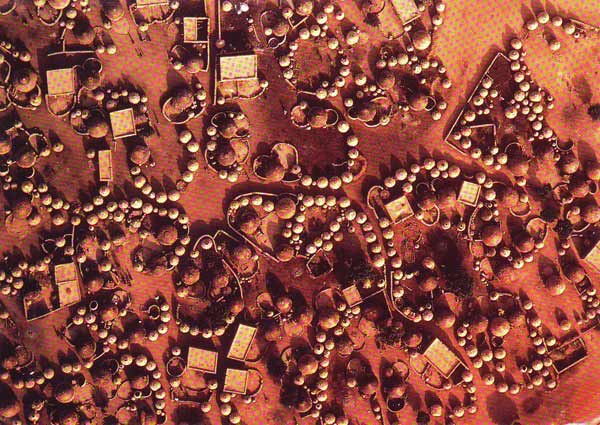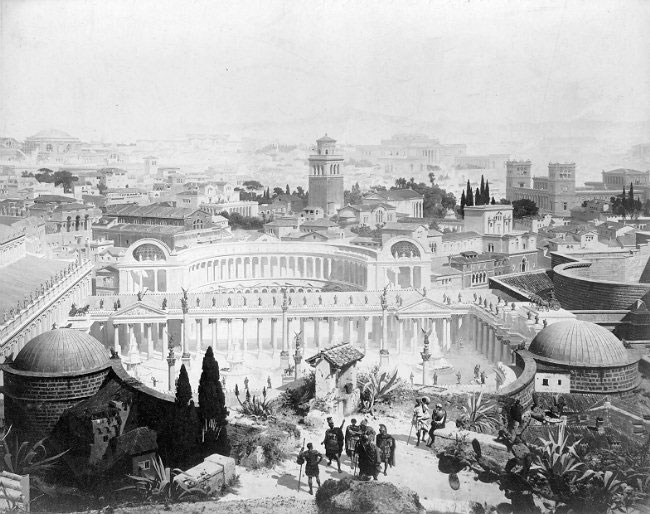

001 what is urban design?
This is a village
of the Dogon people of Mali, a place where life is hard. The Dogon, who
are also famous astronomers, have a dead eye for design, and a
fascinating style of architecture, based on an absolute minimum of
resources. Here, they demonstrate that high design can be absolutely
free when a people cultivates its traditions. And any Dogon would
likely have a hard time understanding a fool Western argument debating
the aesthetic versus the functional. 'Design', as Charles Jencks and Nathan Silver once expressed it in a wonderful little book called Adhocism, 'is what everybody does all the time'. There's no better introduction to a very slippery subject. Do you know precisely what 'urban design' is, or 'planning', or where the two terms intersect, where they differ? No you don't, but there's no need to feel embarrassed about it; no one else does either. Though it's been practiced since the beginning of history, the term 'urban design' was only invented in the 1950's, at a Harvard symposium. 'Planning' goes back only to the 1860's, and some of the other words used in Europe, such as urbanismo in Italy or Städtebau in Germany, aren't as old as that. The academics are as clueless as anyone; look up the definitions in a few dictionaries and encyclopaedias, and you'll soon see just how confused they are. One would think the building of cities was a rather important business. Upon reflection, it may seem a little shocking that we have such a casual approach to the subject. But then, maybe that's why our cities are such wretched places. Though a subtle art, in its essence urban design is hardly a complex one. Brazilian architect Lucio Costa famously won the plan competition for the new capital Brasilia with a drawing scrawled on the back of an envelope. Gordon Cullen, whose The Concise Townscape provides a master course for learning how to see the city around us, offers what might be the simplest and most perfect explanation of all: 'One building is architecture but two buildings is townscape'. A more academic, and somewhat limited definition comes from Cliff Moughtin: 'urban design is the art of arranging buildings to form unified compositions'. The mere fact that we have to ask such questions says a lot. It reminds us that much that is important was lost, and that our communities have suffered for it. Now, when we try to imagine how the future unified city, the city made whole, can look, we will have to find our way back to this neglected art. Americans have spent two centuries building new settlements from the ground up, and it is only natural that we should still have something of the frontier mentality imprinted on our minds. We are accustomed to think it natural for cities to grow up haphazardly. And because our urban environments seem so ephemeral, doomed to certain change or decay, there's no sense exerting ourselves to make them special. Maybe it's time to put childish ways aside. That begins with the realization that a city or town or village is properly an expression of the will of the community; like any other human artifact, it can be built well or poorly. It can express the aspirations of a civilization, or at worst, raise doubts as to whether that civilization has any aspirations at all. Before we go any further, we know many readers are already imagining this question in terms of the politics their televisions and radios blare out at them each day. They're thinking, he wants more government initiatives and government control, and less rights for citizens over their own property. No, he doesn't. It would be easy to demonstrate that the government already exercises too much power over urban development, and that its interventions do more harm than good. A supporter of government 'planning' might ask, 'Do you think New York City would be a finer place without Central Park?' It sure wouldn't, but bear in mind that Central Park was promoted not by government, but by a poet and a newspaper. A popular movement used government as its instrument to reach a civic goal. The greatest age for physical improvements in our cities was between 1880 and 1920, including the heyday of the 'City Beautiful' movement. Yet in that time cities had no zoning, no professional planning staffs, and far less regulatory control than they do today. What makes cities better is not central control and political initiative, but a widespread appreciation and understanding of good urban design—so that whoever makes the decisions, we build well. 
Trajan's Forum, Rome
Architecture, by some, is held to be the highest art, because in it beauty and utility coincide. Urban design has always been an architect's job, and perhaps the highest one; shaping the city is necessarily a more exalted concern than any individual building. Vitruvius, in the oldest extant book on architecture, begins not with the principles of building or a discussion of the classical orders, but with the founding of towns, the rules for siting them to assure the health of their people, how to lay out their streets and place their important buildings. Mirroring the old Roman's famous desiderata for architecture, the qualities of 'firmness, commodity and delight', we might say that urban design has three purposes: to make a city work efficiently and well Urban design and architecture are the only artistic endeavors that affect all of us every day. They are the arts we live in, and their benefits are available in an aesthetic and also a practical sense to everyone in the city, regardless of class or condition. We said that design was the province of architects, but this is only partially true. In the real world, architects, designers and planners have little to do with the way we lay out streets or plot subdivisions. Developers decide where important buildings will stand, and builders, not architects, put up most of our houses. In truth, everyone in the city plays a part in city-building, and hence in design: government officials, and those who elect them, citizens who attend the public meetings and charrettes, the press-everyone who has a role in building something, and everyone who has a chance to comment on it. However trifling our individual contribution might be, it's not something to be slighted. As the psychologist R. D. Laing once put it, we have a positive need to shape the environment around us to stay sane, to give ourselves an identity, to leave something behind. In the long run, urban design is the work of the community. Buildings and people effect each other mutually, and we can take the visual city as a mirror, a symbol of what is going on in the community's mind and heart. If design is 'what everybody does all the time', then the quality of design is an accurate measure of the level of civilization of a people. If the average man has a refined eye, and a sense of what is fitting and right, the average builder will too. Like planting trees, this is an art that aims for the future, into the lives of our children and beyond. If the Congress had written into the Land Ordinance of 1785 a requirement that each new town founded in the Northwest Territory must plan for a green square or a few squares, or a certain amount of inalienable common land at the heart in whatever shape, how much finer would our Midwestern cities be today? Maybe we should be thinking about the future right now. Our way of building today is something that no one can praise or defend. But as urban historian Josef W. Konvitz puts it: 'Nothing may look less likely to change in a radical way than the status quo in city building, but nothing else may be more likely...What the Third Industrial Age will be like remains to be seen'. Reasons to suspect great change in the near future are not limited to the transient, fly-by-night nature of what we build now, the metal sheds and stapled-together houses with 30-year guarantees. The sheer scale of the newer neighborhoods, which only make sense assuming universal car ownership and cheap fuel, may well not be sustainable in coming years. There is also the fond possibility of revulsion finally welling up with our trashy habits of city-building, as it did a century ago over the squalor and anarchy of the old industrial city. Sprawl and inner-city decay, the two great evils besetting our towns today, are two sides of a coin. Design has a critical role to play in both, in the rebuilding of centers and devastated neighborhoods, and in cleaning up the messes and creating real neighborhood centers in the fringe suburbs. In both, the underlying problem of our time is not an aesthetic failing, but something that goes to the heart of our life in community. Blame it on the automobile, or on neurotic architecture, or paranoia over crime, race and class or whatever you like, but I think we can admit that Americans have become somewhat fearful, reluctant to go out among their fellow citizens except under closely controlled circumstances. 'The street', the place where we meet our neighbors, has become a trope for everything that is dangerous and unpleasant. That, of course, is part of our hangover from the Catastrophe of the postwar decades. But it had been growing a long time before that. Ever since the wealthier citizens of the cities started withdrawing into enclaves of their own, that process built on itself. Every step in the creation of the class enclave demeaned 'the street', the public space of the city, and made it harder to appreciate, harder to defend. For the sake of the city, for community, nothing could be more important than stopping, and then reversing this process. Restoring the public space, bringing the city's people back together, is the job at hand. With a little good will, that is a job urban design can do. |
|